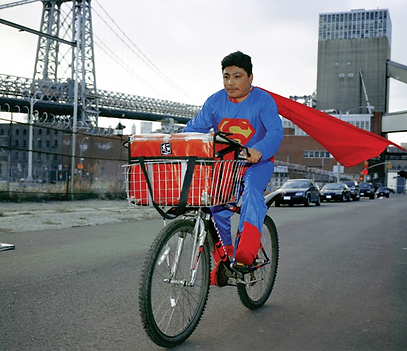Theme Work
The following is an excerpt from an essay in Teaching Contemporary Art with Young People by Connie Stewart.
The theme of Work addresses the lived experiences of our students and their families. It acknowledges those students whose need to work can conflict with their school requirements. It can honor those parents whose work allows little time for school involvement. Looking at Work through art-making reexamines whose labor is essential for a society’s wellbeing, honors the hard work of families in our communities and looks at global labor providing the commodities we enjoy.
Jay Lynn Gomez

Jay Lynn Gomez (formerly Ramiro Gomez) is interested in knowing “Who does the work?” Gomez confronts art lovers coming to major museums with the fact that someone will be picking up the trash and cleaning the floors after their visit.
In Denver, the worker might be Lupita Velazquez. Lupita shares a common profession with Gomez’s mother, a custodian for a public school. Lupita says that she often is not noticed even as she holds a clean door open for arts patrons going into the next gallery.
To honor her, Gomez painted cardboard cutouts of Lupita, placing the cutouts in the museum spaces to show her quiet work and for the workers themselves to see their own value.
In that way, her art can be used for students to honor their own work and that of their families.
Ramiro Gomez
Lupita 2
2017
Ibrahim Mahama

Ibrahim Mahama
Check Point Sekondi Loco 1901–2030
2016-2017
Where does your chocolate come from? Mahama reconstructs or arranges found objects to tell the story of commodities and the role of labor within international trade and the global economy. The discarded objects used in his art installations highlight where common consumer items come from and ask questions about whose work facilitates the worldwide exchange of food and goods, including cocoa.
He is known for repurposing jute or burlap sacks to dramatically cover architectural structures, first in Ghana and then around the world. When the bags are new they are used to transport cocoa. After their use in the cocoa trade the bags are used for coal and other purposes until they reach a point of distress and decay and need to be discarded. At that point Ibrahim purchases the old bags or trades them by providing new ones.
The surface of the material tells the story of the farmers, the tradesmen, and the street vendors who use the bags at different times in their life cycle. He works with collaborators often occupying public spaces to emphasize artistic labor involved in creating monumental artworks.
Dulce Pinzon

Dulce Pinzon
Superman
2017
Heroes leave their ordinary lives to travel to distant lands that contain both treasure and danger.
They accomplish superhuman deeds and often return with a “boon” for those they left behind.
Dulce Pinzon’s series “The real story of Superheroes” asks if maybe those heroic journeys are occurring every day, in plain sight, and yet unrecognized. The workers are identified only by their jobs with their own stories untold.
Pinzon photographed workers in costume so they can be recognized as heroes and heroines. Catwoman was Minerva Valencia from Puebla. She worked as a nanny in New York. The Hulk was Paulino Cardozo. He unloaded grocery trucks. Wonder Woman was Maria Luisa Romero who worked in a laundromat. The satirical Mexican superhero El Chapulín Colorado was Adalberto Lara who worked as a construction worker.
Each of these workers sends a substantial portion of the money they earned back to their families each week. For example, Superman Noe Reyes worked for ten years delivering restaurant meals by bicycle. He sent $500 a week to his family and paid for his siblings’ university education (Murphy, 2006). Each photo is labeled with the superhero, the immigrant’s name, home country, city or region and the amount of earnings given to their families weekly.
What heroes are not seen because they just need a costume?
